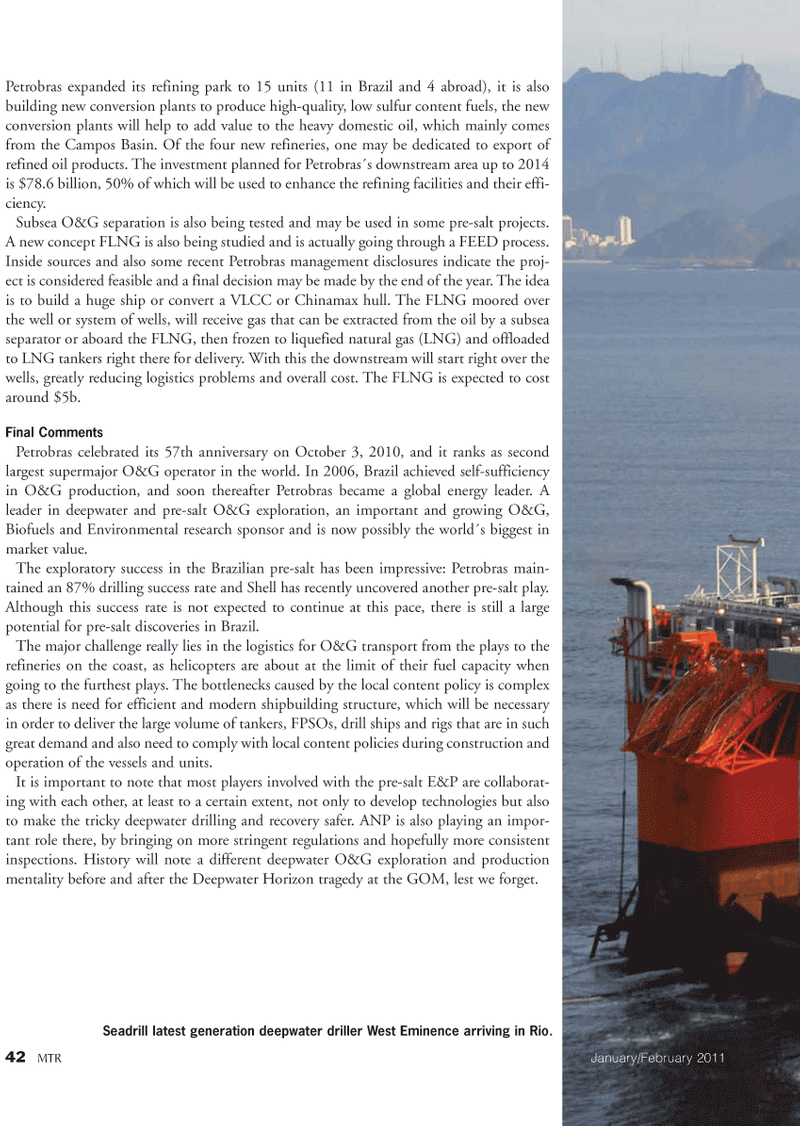
Page 42: of Marine Technology Magazine (January 2011)
Marine Salvage & Recovery
Read this page in Pdf, Flash or Html5 edition of January 2011 Marine Technology Magazine
42 MTR January/February 2011
Seadrill latest generation deepwater driller West Eminence arriving in Rio.
Petrobras expanded its refining park to 15 units (11 in Brazil and 4 abroad), it is also building new conversion plants to produce high-quality, low sulfur content fuels, the new conversion plants will help to add value to the heavy domestic oil, which mainly comes from the Campos Basin. Of the four new refineries, one may be dedicated to export of refined oil products. The investment planned for Petrobras´s downstream area up to 2014 is $78.6 billion, 50% of which will be used to enhance the refining facilities and their effi- ciency.
Subsea O&G separation is also being tested and may be used in some pre-salt projects.
A new concept FLNG is also being studied and is actually going through a FEED process.
Inside sources and also some recent Petrobras management disclosures indicate the proj- ect is considered feasible and a final decision may be made by the end of the year. The idea is to build a huge ship or convert a VLCC or Chinamax hull. The FLNG moored over the well or system of wells, will receive gas that can be extracted from the oil by a subsea separator or aboard the FLNG, then frozen to liquefied natural gas (LNG) and offloaded to LNG tankers right there for delivery. With this the downstream will start right over the wells, greatly reducing logistics problems and overall cost. The FLNG is expected to cost around $5b.
Final Comments
Petrobras celebrated its 57th anniversary on October 3, 2010, and it ranks as second largest supermajor O&G operator in the world. In 2006, Brazil achieved self-sufficiency in O&G production, and soon thereafter Petrobras became a global energy leader. A leader in deepwater and pre-salt O&G exploration, an important and growing O&G,
Biofuels and Environmental research sponsor and is now possibly the world´s biggest in market value.
The exploratory success in the Brazilian pre-salt has been impressive: Petrobras main- tained an 87% drilling success rate and Shell has recently uncovered another pre-salt play.
Although this success rate is not expected to continue at this pace, there is still a large potential for pre-salt discoveries in Brazil.
The major challenge really lies in the logistics for O&G transport from the plays to the refineries on the coast, as helicopters are about at the limit of their fuel capacity when going to the furthest plays. The bottlenecks caused by the local content policy is complex as there is need for efficient and modern shipbuilding structure, which will be necessary in order to deliver the large volume of tankers, FPSOs, drill ships and rigs that are in such great demand and also need to comply with local content policies during construction and operation of the vessels and units.
It is important to note that most players involved with the pre-salt E&P are collaborat- ing with each other, at least to a certain extent, not only to develop technologies but also to make the tricky deepwater drilling and recovery safer. ANP is also playing an impor- tant role there, by bringing on more stringent regulations and hopefully more consistent inspections. History will note a different deepwater O&G exploration and production mentality before and after the Deepwater Horizon tragedy at the GOM, lest we forget.

 41
41

 43
43
